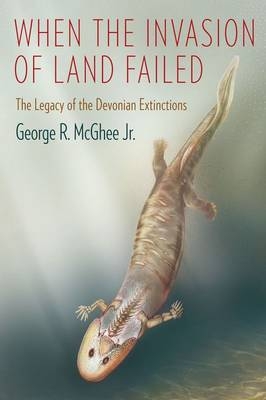
When the Invasion of Land Failed
The Legacy of the Devonian Extinctions
Seiten
2013
Columbia University Press (Verlag)
978-0-231-16057-5 (ISBN)
Columbia University Press (Verlag)
978-0-231-16057-5 (ISBN)
- Lieferbar (Termin unbekannt)
- Versandkostenfrei
- Auch auf Rechnung
- Artikel merken
The invasion of land by ocean-dwelling plants and animals was one of the most revolutionary events in the evolution of life on Earth, yet the animal invasion almost failed-twice-because of the twin mass extinctions of the Late Devonian Epoch. Some 359 to 375 million years ago, these catastrophic events dealt our ancestors a blow that almost drove them back into the sea. If those extinctions had been just a bit more severe, spiders and insects-instead of vertebrates-might have become the ecologically dominant forms of animal life on land. This book examines the profound evolutionary consequences of the Late Devonian extinctions and the various theories proposed to explain their occurrence. Only one group of four-limbed vertebrates exists on Earth, while other tetrapod-like fishes are extinct. This gap is why the idea of "fish with feet" seems so peculiar to us, yet such animals were once a vital part of our world, and if the Devonian extinctions had not happened, members of these species, like the famous Acanthostega and Ichthyostega, might have continued to live in our rivers and lakes.
Synthesizing decades of research and including a wealth of new discoveries, this accessible, comprehensive text explores the causes of the Devonian extinctions, the reasons vertebrates were so severely affected, and the potential evolution of the modern world if the extinctions had never taken place.
Synthesizing decades of research and including a wealth of new discoveries, this accessible, comprehensive text explores the causes of the Devonian extinctions, the reasons vertebrates were so severely affected, and the potential evolution of the modern world if the extinctions had never taken place.
George R. McGhee Jr. is Distinguished Professor of Paleobiology at Rutgers University and a Member of the Konrad Lorenz Institute for Evolution and Cognition Research in Klosterneuburg, Austria. He has held research positions at the University of Tubingen, the Field Museum of Natural History, and the American Museum of Natural History.
Preface 1. The Evolution of Life on Land 2. The Plants Establish a Beachhead 3. The First Animal Invasion 4. The First Catastrophe and Retreat 5. The Second Animal Invasion 6. The Second Catastrophe and Retreat 7. Victory at Last 8. The Legacy of the Devonian Extinctions Notes References Index
| Reihe/Serie | The Critical Moments and Perspectives in Earth History and Paleobiology |
|---|---|
| Zusatzinfo | <B>Color Illus.: </B>12,, <B>B&W Illus.: </B>48, |
| Verlagsort | New York |
| Sprache | englisch |
| Maße | 152 x 229 mm |
| Themenwelt | Naturwissenschaften ► Biologie |
| Naturwissenschaften ► Geowissenschaften ► Mineralogie / Paläontologie | |
| ISBN-10 | 0-231-16057-7 / 0231160577 |
| ISBN-13 | 978-0-231-16057-5 / 9780231160575 |
| Zustand | Neuware |
| Haben Sie eine Frage zum Produkt? |
Mehr entdecken
aus dem Bereich
aus dem Bereich
Buch | Softcover (2024)
Shaker (Verlag)
CHF 27,70
An Optimist's Guide to the Historical Sciences
Buch | Softcover (2024)
MIT Press (Verlag)
CHF 48,35


